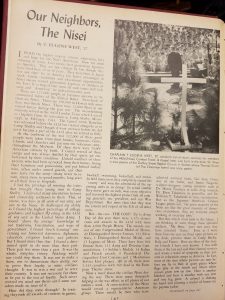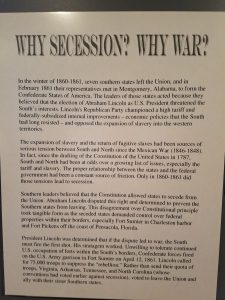By Joshua Kim
“Watchful waiting, sleepless nights, and “Injun” scalping, but for the scalping on the football field held tomorrow, will come to a glorious climax tonight when the leaping flames of the largest Thanksgiving bonfire ever built by the student body will proclaim to the campus and the nearby city of Richmond the intentions of the Spider squad at tomorrow’s annual game” (Collegian, 1940).
These are the first lines of an article found in the University of Richmond Collegian newspaper–dark, ominous sentences describing a metaphorical scalping of “Injuns.” The word “Injun” dates back to the early 1800s, a slang term to describe indigenous people in the U.S. It is now recognized as outdated and offensive, a calculated mispronunciation of the word “Indian” as a means to mock indigenous people.
The article discusses a rivalry between Richmond and William & Mary in which the teams enthusiastically participate in multiple events, such as a cheer out, a bonfire celebration — with cheerleaders and a marching band — and a mock scalping, all grossly misconstrued variations of “indigenous”culture.
“Along with other pre-game activity came the capture Monday night of 18 boldly brazen Indian braves…but the Spiders…left silent testimony of their victory with the effect of slashing shears on Indian scalps” (Collegian, 1940).
Although we don’t practice mock scalpings anymore, we still find plenty of problematic behavior within our student body.
On October 24, 2016, the University of Richmond Collegian published an article describing how a student government senator posted a photo of himself dressed as a “Native American.” His costume consisted of a Washington Redskins jersey, feathers in his hair, and red paint on both his arms and face (Collegian, 2016).
Seventy-six years later, we find ourselves continuing to perpetuate harmful stereotypes of indigenous people. Although they are unique cases, we must address the similarities between the two events, namely the role of power structures.
After further research of the 1940s event, I was unable to locate anything to suggest that the Richmond students who had kidnapped and “scalped” the 18 William & Mary “Indians” ever faced any form of punishment from the university.
This suggests that the University of Richmond either did not care about, or approved of, its students’ problematic, faux-Indian traditions, even participating themselves:
“President F. W. Boatwright of the University of Richmond and President John Stewart Bryan of William and Mary spoke from their respective schools at a joint radio rally held last night over station WRVA” (Collegian, 1940).
What we see here is a power structure openly supporting the harmful misrepresentation of an underrepresented group, but this should not come as a surprise as playing “Indian,” and cultural appropriation in general, was commonplace in the 1940s.
A week before the Collegian had posted its article about the RCSGA senator in redface in 2016, the senator resigned from his position.
With such a pertinent issue at hand, it would have seemed as if the senator would have faced harsher punishment from both student government and from the university, but instead he quietly resigned, and the matter almost instantly disappeared.
While some would say that justice had been served, others would disagree.
For its article, the Collegian interviewed several people, including Richmond alumnus Young Brinson, a member of the Cheroenhaka Nottoway tribe of Virginia. In the article, Brinson expressed her frustration with the event, pointing out that her culture was not someone else’s costume. Furthermore, she touches on the subject of the usage of Indigenous culture as mascots in sports culture, and the hypocrisy with American perspective on what is, and is not racist:
“Having a football team named Redskins is disrespectful on a historical level when they used to call us that on a derogatory level,” Brinson said. “You would never see a team with blackface as their mascot. So why are you doing this to us? It’s disrespectful” (Collegian, 2016).
Brinson brings up a very fair point: If the senator had been caught in blackface, would he have faced harsher consequences from the university?
From what we may garner from the university’s reaction, the answer is yes because the university does not acknowledge the violent history that they once exemplified towards the indigenous population.
Almost a century later we find ourselves reflecting the same attitude and behavior towards indigenous people as we did in 1940. This is quite contradictory to the image the university portrays.
The university advertises itself as a campus of culture, one that boasts a diverse student population, but how can it say that when it has not learned from its past?
This is a very troubling question, but what it leads me to believe is that it is not the fact that redface is less offensive, but rather the lack of exposure to indigenous culture has silenced indigenous oppression, leading non-indigenous students to commit these acts in complete ignorance.
According to the Collegian article, only 0.3 percent of students at Richmond identified as American Indian or Alaska Native in 2014 (Collegian, 2016). Compare this to 6.1 percent Asian, 7.8 percent Black/African American, and 7 percent Latino, and you can see that the indigenous population on campus is a minority group within a minority group.
Consequently, you can see how difficult it must be for indigenous students to organize and educate the culture at Richmond.
Does this mean that the lack of representation of indigenous students is justification for the offensive acts? Absolutely not. With the access to resources we have today, there is no reason why college-educated adults should remain uneducated about the subject.
Yet, this is why these findings are so troubling.
Our access to the internet gives us a huge resource advantage over our peers from 1940, yet we continue to appropriate indigenous culture and remain ignorant to their history. Even more troubling is the fact that the power structures at the university are complicit in this ignorance and violence.
President Boatwright rallied the students to victory. The senator was simply allowed to resign.
No justice was pursued. No educational efforts were attempted. Even if the administration found no reason to punish the student, it should have realized that it was the perfect opportunity to educate both the students, and the campus as a whole, about indigenous culture.
What could have been a moment to uplift indigenous voices instead became one that silenced them.
The archive reveals that our past is nothing more than our present, and it will become our future if we do not take active action to stop it.
(More on William & Mary’s history with sports and indigenous culture here).
Joshua Hasulchan Kim is from Colonial Heights, Virginia. He is a sophomore at the University of Richmond who is double majoring in Journalism and French. Joshua is involved in various clubs on campus: He is the co-president of Block Crew dance crew, the opinions editor for the Collegian newspaper, and is the Co-Director of Operations for the Multicultural Lounge Building Committee. Joshua developed this blog post as part of his work on a Spring 2017 independent study (RHCS 387). He will be continuing his research with the Race & Racism at the University of Richmond Project during Summer 2017 with the support of an A&S Summer Research Fellowship.


